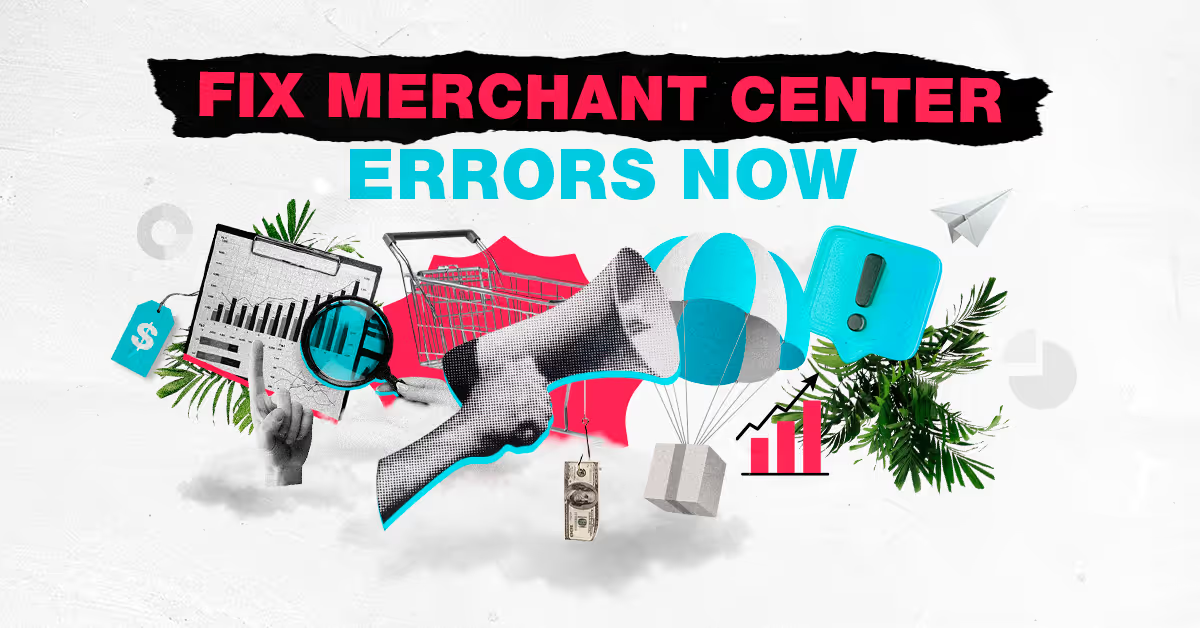
Auto parts sellers face unique challenges when using Google Merchant Center. The specialized nature of automotive products creates frequent disapproval issues that can frustrate even experienced merchants. I've helped numerous automotive clients overcome these exact hurdles and seen firsthand how these disapprovals can halt campaigns and impact sales.
When an auto parts listing gets disapproved, it's not just an annoying notification - it means your products won't appear in Google Shopping ads until fixed. For parts sellers with thousands of SKUs, these disapprovals can significantly impact visibility and revenue.
In this guide, I'll walk through the most common Google Merchant Center disapproval issues specifically for auto parts. You'll learn actionable solutions to get your products approved and selling. Let's solve these frustrating roadblocks together.
Google Merchant Center serves as the gateway for getting your auto parts displayed in Google Shopping. Unlike standard consumer products, auto parts face additional scrutiny due to their technical nature and the regulations surrounding automotive components.
The automotive aftermarket industry presents unique challenges in Google Merchant Center. Parts compatibility information, technical specifications, and regulatory compliance all factor into Google's approval process. Understanding these industry-specific requirements is essential for success.
When working with auto parts clients, I notice certain disapproval patterns emerge consistently. Let's examine the data on why auto parts get flagged more frequently than other product categories.
These disapprovals don't just delay your campaigns—they directly impact your bottom line by preventing your products from appearing in valuable Google Shopping placements. The good news? Most can be resolved with the right approach.
Successfully optimizing your Google Shopping product feed requires attention to detail, especially for complex products like auto parts. Let's look at each major disapproval category and how to solve it.
Image issues top the list of auto parts disapprovals. Google maintains strict image requirements that many automotive sellers struggle to meet consistently across large inventories.
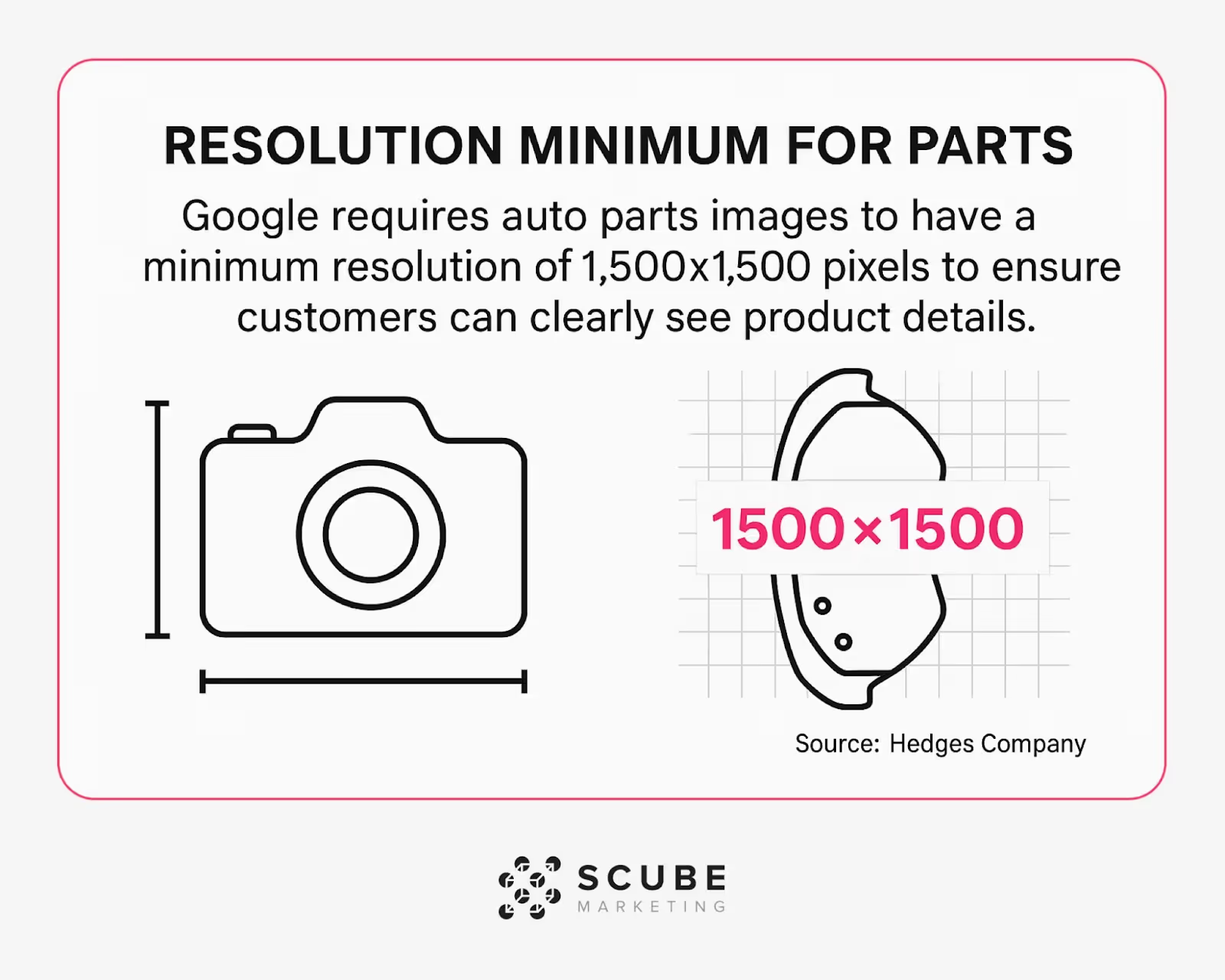
Google requires auto parts images to have a minimum resolution of 1,500x1,500 pixels to ensure customers can clearly see product details. (Source: Hedges Company)
Unlike fashion or home goods, auto parts often have complex shapes and technical details that must be clearly visible. Google's algorithms specifically check that automotive product images:
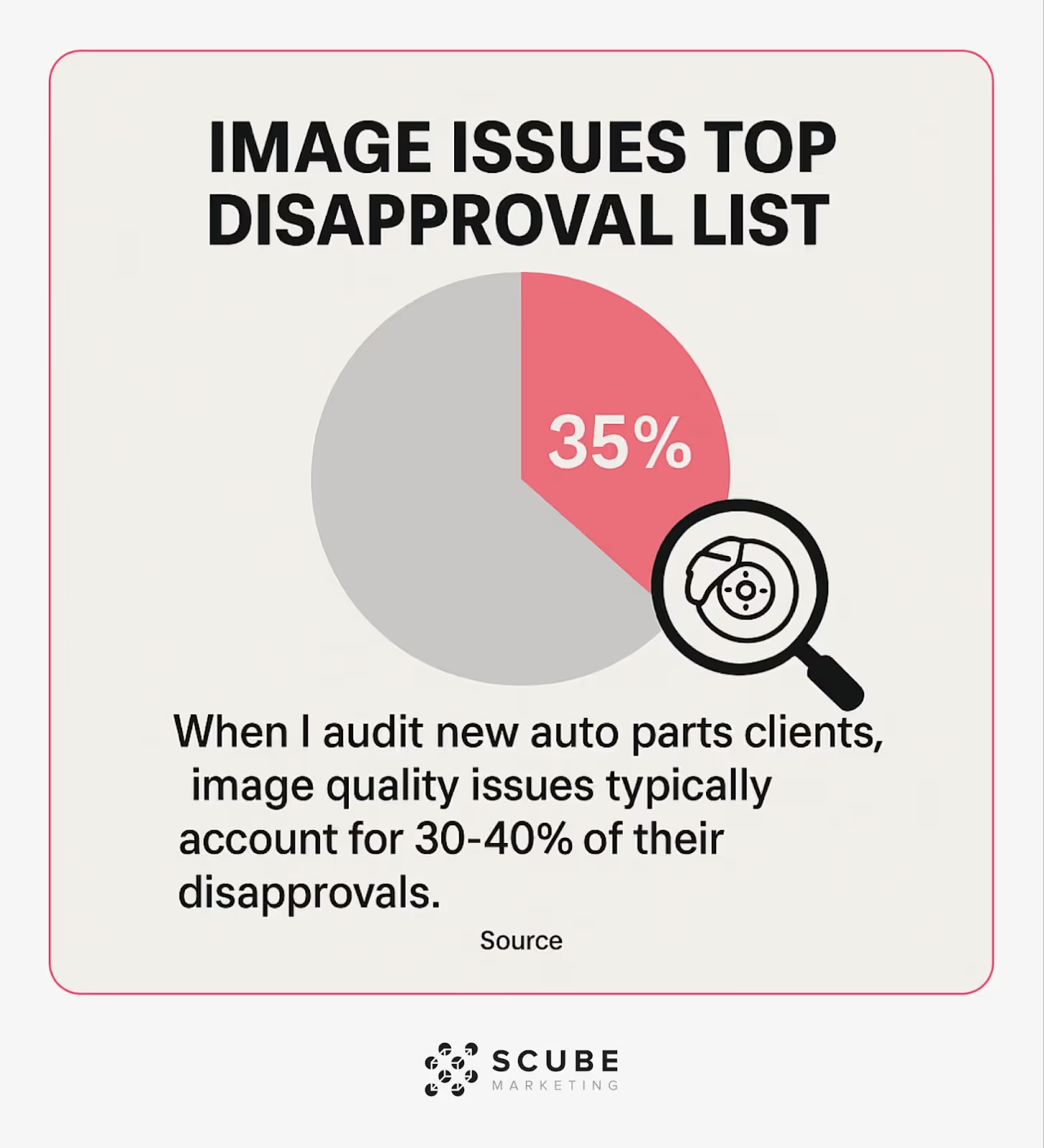
When I audit new auto parts clients, image quality issues typically account for 30-40% of their disapprovals. The fix is straightforward but requires resources to implement at scale.
For complex auto parts, single images often don't suffice. Consider providing multiple angles to show various connection points, mounting hardware, or functional elements. This is particularly important for:
Many sellers focus only on meeting the minimum requirements, but I've found that providing additional images not only helps with approval but also reduces return rates, as customers better understand exactly what they're purchasing.
A common mistake I see with auto parts merchants is using images that show the part installed on a vehicle. While this seems helpful for customers, Google specifically requires standalone product images for most categories.
Here's a practical guide for optimizing your auto parts images:
Addressing these image issues resolves a significant percentage of auto parts disapprovals. When working with automotive clients, upgrading image quality is often our first recommendation because it delivers the quickest approval rate improvements.
Policy violations create some of the most challenging disapproval scenarios for auto parts sellers. These often require more nuanced solutions than simple technical fixes.
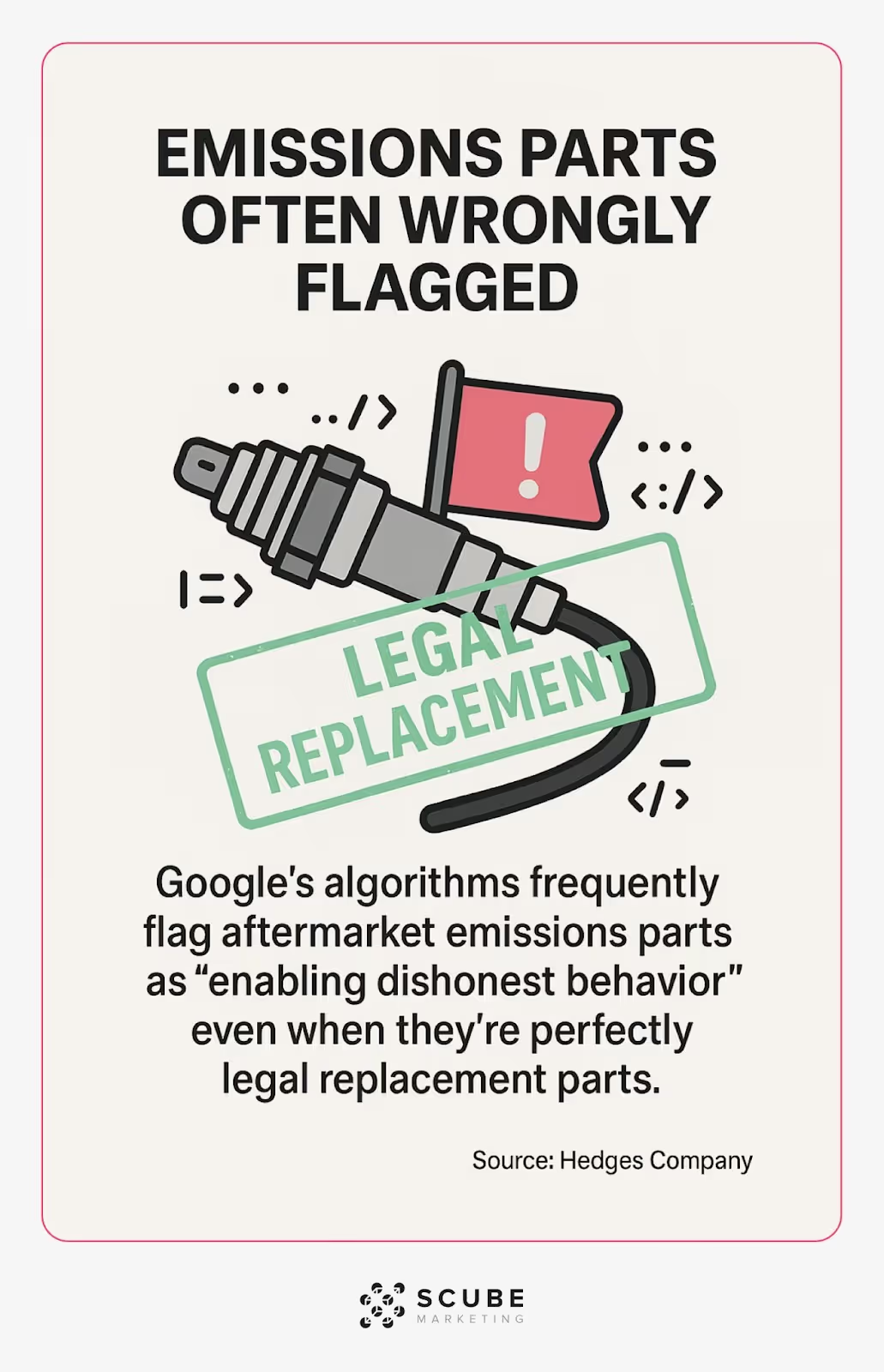
One of the most frustrating disapproval issues for auto parts sellers involves emissions-related components. Google's algorithms frequently flag aftermarket emissions parts as "enabling dishonest behavior" even when they're perfectly legal replacement parts. (Source: Hedges Company)
The key issue stems from Google's policies against selling products that could be used to circumvent regulations. Categories particularly vulnerable to these flags include:
When listing these products, it's crucial to clearly indicate they are legal replacement parts that meet OEM specifications. Understanding what makes a proper MPN number so important for product listings can help prevent disapprovals since this identifier helps Google verify legitimate parts.
Google explicitly prohibits "defeat devices" designed to bypass emissions controls but allows properly documented replacement parts. This distinction is critical for auto parts sellers. (Source: Hedges Company)
To avoid policy violations for emissions-related parts:
A real-world example illustrates this challenge: one of our clients had a Jeep antenna mast product wrongly flagged as a "dangerous product" by Google's AI systems. (Source: Hedges Company) We resolved this by enhancing the product description with safety specifications and installation guidelines, resulting in approval after resubmission.
For frequently flagged categories, additional documentation in your product feed can make the difference between approval and rejection. I recommend creating detailed product attributes that clearly specify:
The good news is that policy violations can be overcome with the right documentation. There's a 68% approval rate after resubmission with enhanced documentation and data. (Source: Hedges Company)
Pricing discrepancies between your feed and website create frequent disapprovals that can be particularly challenging to troubleshoot. The process of effectively selling auto parts online extends beyond just managing disapprovals to maintaining consistent pricing across all channels.
Dynamic pricing strategies, while effective for auto parts sellers during promotional periods, can lead to Google Merchant Center disapprovals. In fact, 47% of auto parts disapprovals can be traced to flash sale price mismatches between your feed and website. (Source: StubGroup)
This typically happens when:
To prevent these issues, implement a synchronized pricing update system that ensures both your website and product feed reflect the same prices simultaneously.
For auto parts retailers selling internationally, currency conversion presents another common disapproval trigger. Businesses using dynamic currency converters experience 3× higher disapproval rates for price mismatches. (Source: StubGroup)
The problem occurs when Google's crawlers see one price (in the local currency) while your feed shows another (in your base currency). To solve this:
Many of our automotive clients sell internationally, which is why we recommend creating separate feeds for each target market rather than relying on dynamic conversion tools.
Beyond fixing immediate price mismatch issues, implementing systemic solutions can prevent future disapprovals. Consider these approaches for maintaining price consistency:
By implementing these strategies, you can significantly reduce pricing-related disapprovals for your auto parts listings. With increasingly strict requirements for product feeds, staying updated is essential.
Once you've addressed the common disapproval causes, a systematic approach to troubleshooting can help resolve remaining issues efficiently.
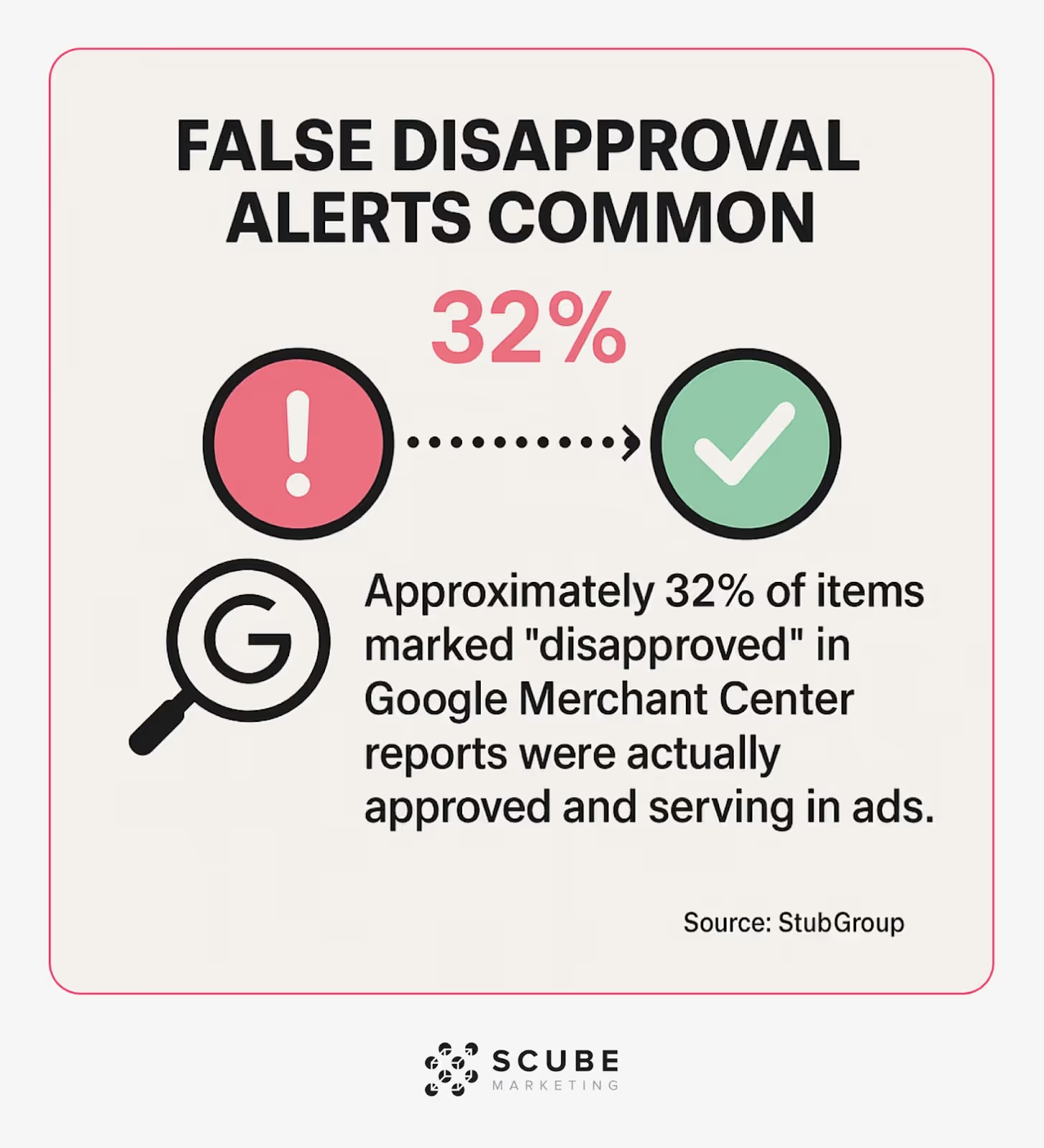
A surprising finding from our experience is that not all "disapproved" notifications are accurate. Approximately 32% of items marked "disapproved" in Google Merchant Center reports were actually approved and serving in ads. (Source: StubGroup)
This creates confusion for merchants who may spend time troubleshooting products that are actually performing correctly. To verify if a product is truly disapproved:
Don't automatically assume all disapproval notifications require immediate action. Verify first to avoid unnecessary work.

When automated systems flag your auto parts, requesting a manual review can be highly effective. Data shows a 68% approval rate after resubmission with enhanced product data. (Source: Hedges Company)
To improve your chances during manual review:
The manual review process typically takes 1-3 business days, but the high success rate makes it worth the wait for valuable products. This is especially true for promotional items where timing is crucial to capitalize on sales events.
When resubmitting previously disapproved auto parts, enhancing your product data significantly increases approval chances. Focus on improving these elements:
By following this structured approach, you can methodically address and resolve auto parts disapprovals in Google Merchant Center.

Successfully navigating Google Merchant Center disapprovals for auto parts requires understanding the unique challenges of this category. From stringent image requirements to emissions-related policy concerns, pricing synchronization to technical data accuracy—each aspect requires careful attention.
The good news is that most disapprovals are resolvable with the right approach. By implementing the strategies outlined in this guide, you can significantly reduce disapproval rates and keep your auto parts products visible in Google Shopping, driving more qualified traffic to your store.
Remember that persistence pays off in this space. Even with initial disapprovals, the high success rate of manual reviews (68%) demonstrates that Google is willing to approve properly documented auto parts when you provide the right information.
If you're struggling with persistent Google Merchant Center issues for your auto parts business, consider working with a specialized team that understands both Google Shopping and the automotive aftermarket. Sometimes an expert perspective can quickly identify and resolve issues that might otherwise take weeks of trial and error.
Have you encountered unique disapproval issues with your auto parts listings? Share your experiences in the comments below, and I'll be happy to provide additional guidance.